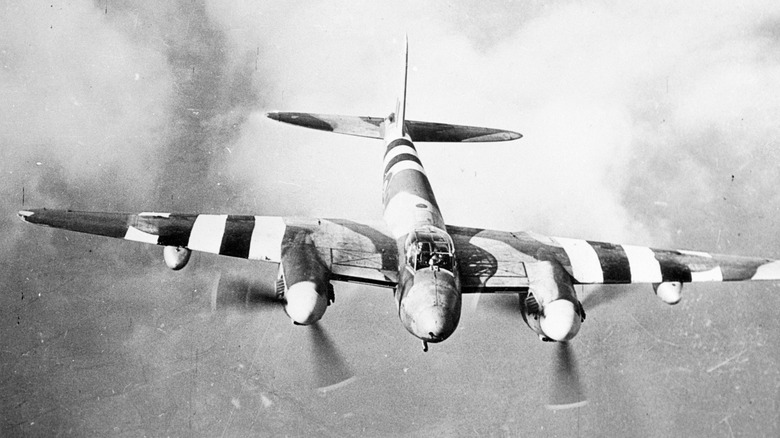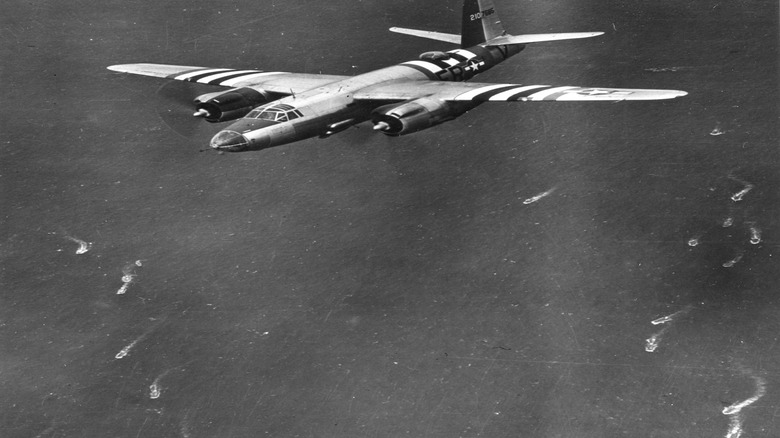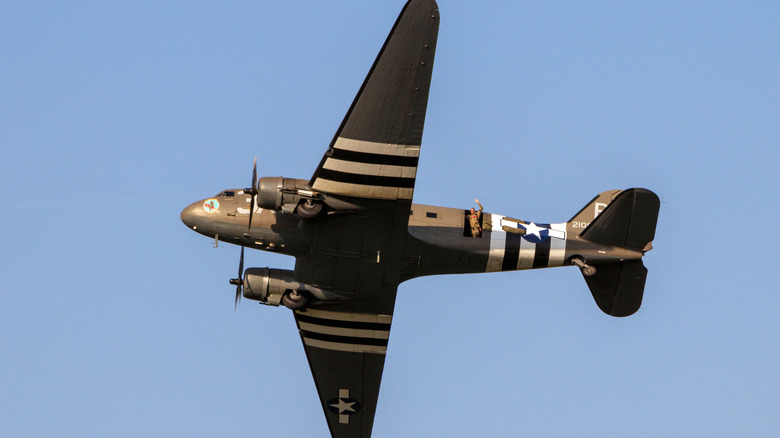Why Did WW2 Planes Have Black And White Stripes?
History buffs know the image well: a score of U.S. fighter planes sporting the now-iconic black and white stripes across their wings soaring over Normandy as the Allies mounted one of the most infamous military operations in modern history. In the eighty-one years since D-Day, these images of Operation Overlord has have puzzled and intrigued casual observers, wondering why Allied aircraft did their best zebra impersonation for the most important operation of the war.
These unique markings were called Invasion Stripes, and the history behind them is as fascinating as the aircraft they were painted on. Born out of one of the war's great disasters, the stripes are one of many examples of the era's warplanes sporting strange identification markers, such as when German fighters sported red spirals or U.S. planes boasted personalized nose art. In this case, however, the Second World War's most ingenious use of aviation art was more than decoration and is now a lasting example of how the era's tacticians adjusted to a changing military landscape.
History of invasion stripes
The Allied forces' decision to paint black and white stripes across the top and bottom of their wings was a fratricide preventative measure born of one of the largest friendly fire disasters of the war. Dubbed the Mackall disaster, U.S. forces lost twenty-three planes and over one hundred dead or missing soldiers as Allied ground forces shot down a paratrooping mission over a Sicilian beachhead. To that point, it was the largest case of friendly fire in the war's history and served as a costly lesson for Allied military planners.
When the Allies planned their June 1944 invasion of Normandy, the Mackall disaster was still fresh in their minds. Believing that airspace would be cluttered with Axis and Allied aircraft, military planners needed to devise a way for naval and ground forces to distinguish between the two sides of the brutal conflict. So, twenty days before the fateful day, the Allies finalized a plan for nearly all the Allied Expeditionary Air Force planes involved in the attack, a staggering 11,590 by some accounts, to be painted with alternating black and white stripes, or 'Identification, Friend or Foe' markings, on the wings and fuselage. Known as Invasion Stripes, the markings were a rousing success, effectively limiting friendly fire on Allied aircraft. Unfortunately, the Allies didn't have the presence of mind to extend the same strategy to their ground forces. Just over a month and a half later, U.S. bombers committed the worst episode of friendly fire of the war, accidentally killing 111 soldiers and wounding nearly 500 more.
A lasting legacy
Although Allied air forces had removed the distinctive stripes from their wings by December 1944, the power of those iconic markings lived far beyond their operational usefulness, as the black and white striped aircraft serve as powerful reminders of the sacrifices made during one of the world's most infamous conflicts.
Unfortunately, the need to prevent friendly fire has also continued to live on, as military planners continue to search for new and inventive ways to reduce fratricide. U.S. Army reports in the 1990s estimated that roughly 15% of all American casualties in the 20th century were from friendly fire, including 17 % during Operation Desert Storm. Increasingly complex ground conditions, the growth of guerrilla warfare tactics, and the prevalence of urban combat zones made distinguishing friend from foe particularly difficult during the 20th and 21st century. U.S. military aircraft have a particularly checkered history with friendly fire. In recent headlines, a U.S. Navy F/A-18 Hornet was shot down over the Red Sea following a series of airstrikes on the Houthi-controlled Yemeni capital of Sanaa.
In today's modern landscape, militaries are increasingly pressed to reduce friendly fire incidents. Some high-tech solutions have come to the forefront, including infrared, thermal, and sensor identification systems employed to reduce fratricide. Some militaries have even returned to the model established by invasion stripes and resorted to painting the sides of tanks and vehicles, as was hypothesized when Russian forces painted the mysterious Z on the side of their vehicles during the invasion of Ukraine.


